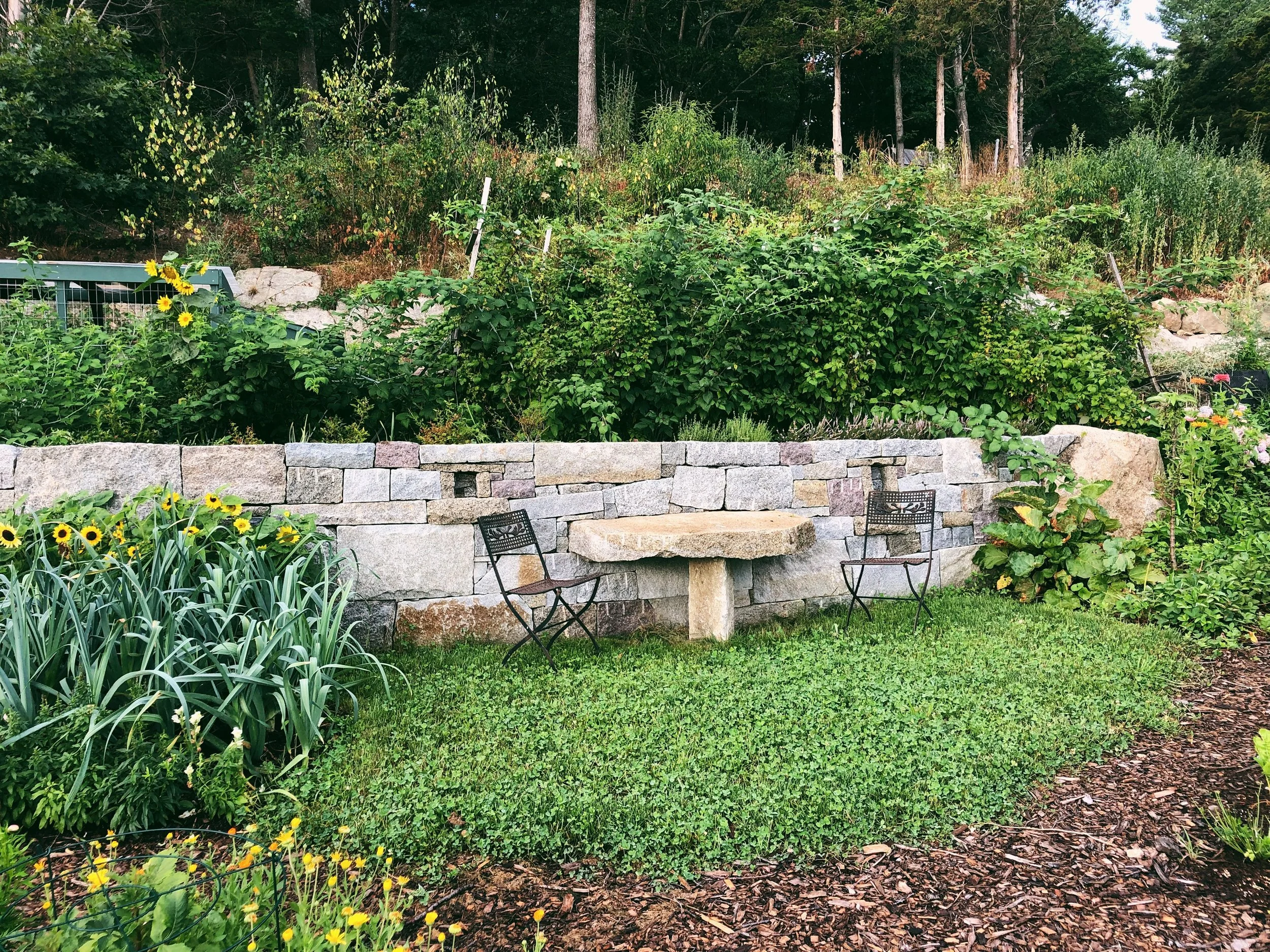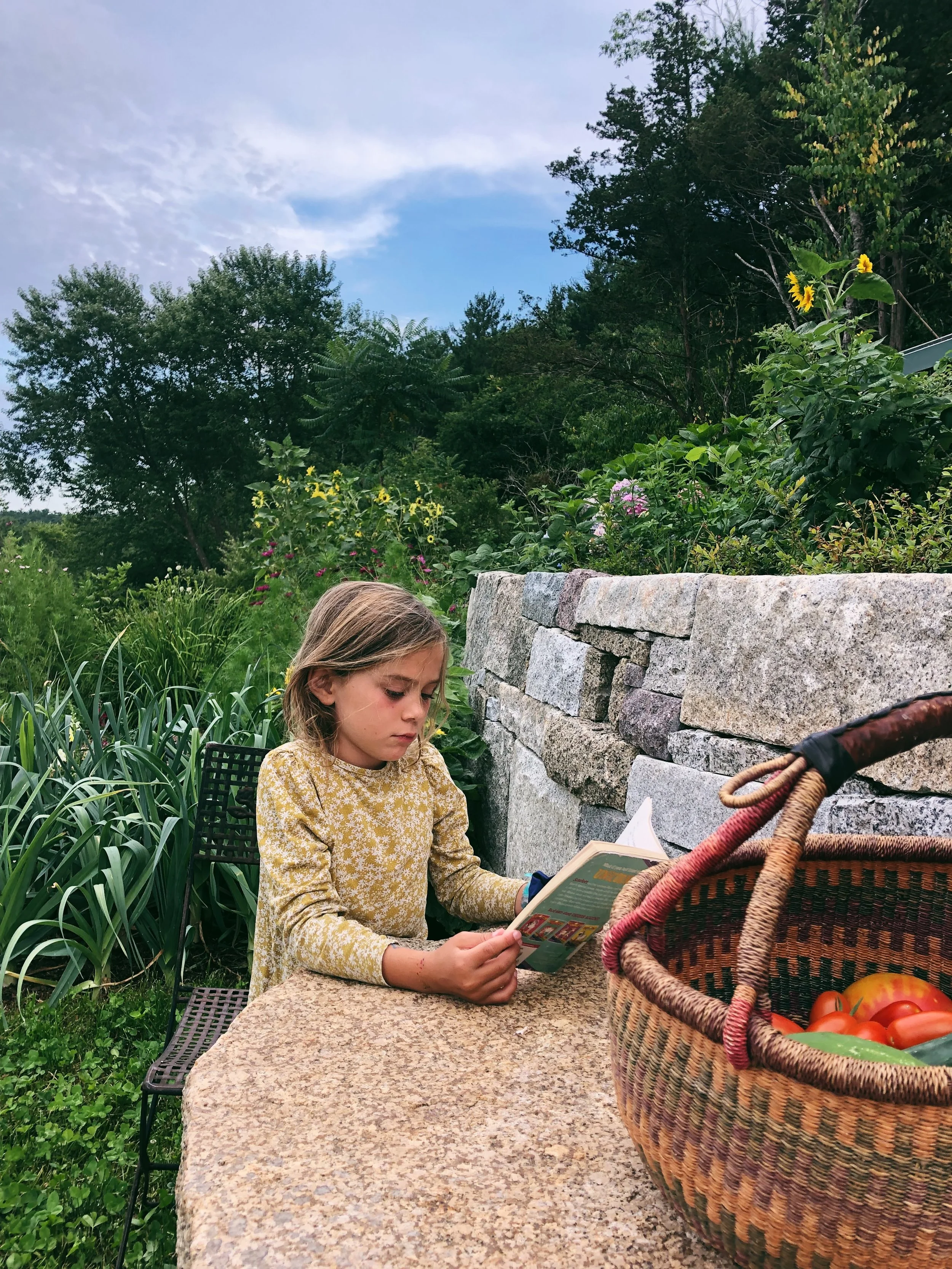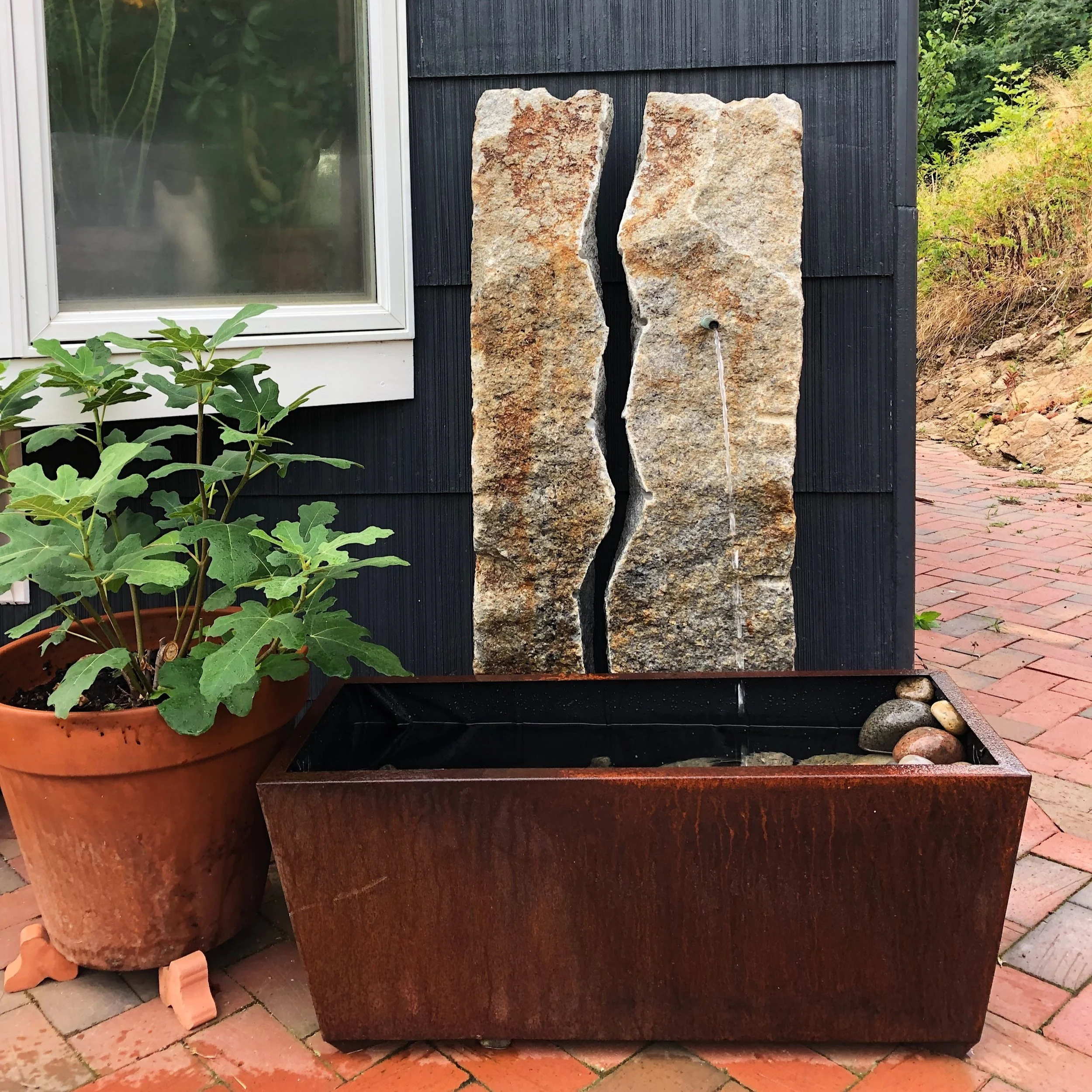July / August 2022
It is early August and early in the morning, the sky is still waking up and a faint mist is in the air. Looking about the garden, walking here and there, I am planning for fall and beginning to sow the last crops to go in the veg garden. It is hard to believe we have come to August, the we are at the tail end of the growing season, now we are counting weeks to the first frost, where just 3 month back we were moving tender plants out in the garden. The days have flown by, and I am busy planning for the fall and winter project on the homestead.
Summer is like that, the anticipation of its coming is so long in the making, starting with the garden planning in winter and building all spring. When it finally does arrive in June there is a sense of an endless to it, winter so long behind us, and the days stretching out ahead make it feel so. But then all of sudden I find we are near the end, it is cool one day, suddenly, apples are ripening, squash turns brilliant orange, and you know it won’t be too long now. But today it is warm enough, summer enough, though the sky is at odds with itself, lines of bright blue skies streak through dark grey clouds, the feeling of a storm, but will it rain today….it hasn’t for so long, we need rain.
July and the beginning of August were hot, day after day of it. But what has really taken it toll is not the heat but the lack of rain. A dry spring turned dry summer. I think the last time it was this dry was the summer/fall of 2016, I can remember walking around the ponds in the woods near us and seeing how low the water was in late fall / early winter, hoping for a snowing winter to soak the earth and refill the bodies of water.
Even so, with heat and lack of rain, August is still a month of rich, semi-wild fullness, heavy with late summer blooms and produces from the veg garden .
It is the end of August now, late summer in the garden, a warm glow and an easy abundance define it. The Sunflowers tower along the upper annual garden and the Rudbeckia, Echinacea and Verbena have been blooming for some time, they quite enjoy these drier conditions. The Cannas and Dahlias are lovely as ever and the sedum is just beginning to be touched with pink, while the tall grasses catch the breeze. Summer blooming alliums dot their way through the garden. The veg garden is bursting with potatoes to be dug and basket of tomatoes to be hauled in, zucchini hiding under spiny leaves and cucumbers running mad, it is a lovely month with so much to do and enjoy.
But at the same time, despite all the fullness of August, it is clearly an end of sorts. The plants have been growing all spring and summer now, and the demands of that growth can start to show. While we can still have warm days, even scorching days, the nights are beginning to be cooler and the days are shortening rapidly. The harvest in the veg garden is a chore to keep up with, but at the same time, the garden can begin to look and feel tired from all that growing.
I employ two strategies at this time in the garden, one is to put some energy back into the garden, there is much you can do to set the garden up to continue going strong well into October. And the second, is to embrace that plants going out, dying back, or setting their seed and is beauty in its own right.
But if you are looking to bring some fresh life to your garden, weeding, fertilizing, touching up mulch and adding some later season perennial or annual flowers / veg can bring fresh life to a garden. I tend to do this mostly to areas of high traffic or places we like to linger, or where we walk or sit every day. Start with making one area the most beautiful, and pick an area that you don’t have to go out of your way to enjoy, something right on your main routes, or a favorite sit spot.
JOBS
Mow your long grass
We have parts of our sloped garden that we let be long grass / meadows, but the end August is a good month to give those areas a cut. For us the cut helps keep the areas free of woody growth and keep down the poison ivy, it is part of maintaining the tall grass and meadow. Once you have made the cut you can keep it cut or let it grow and do another cut in late fall.
For a meadow, what you want to happen is to let the flowers you want in the meadow to go to seed, and for that seed to fall to the soil, then by removing the plant material and cutting it down low, you are creating openings for the seed to be exposed to soil, and sunlight.
Cutting Hedges
Having clipped hedges has been an ongoing experiment for me. And one I have really enjoyed, which I one time, I would not thought that to be the case.
I have read that a late summer clipping is good because you sharpen all that structure going into winter and you are cutting after nesting birds will have gone from the hedge (if the hedge is large enough that it has them) and we aren’t close to winter yet so there is time for the plant to heal over the cuts.
I did not get around to doing a late summer cut last year, I meant too, but I didn’t, so instead I did an early spring cut. This year I hope to carve out some time to try a later summer pruning.
By pruning them in the end of the summer, you will not have a flush of regrowth that you would see in an early spring prune, so you should prune to the shape and size that you desire it to be at until it grows more again next spring.
As always make sure your tools are clean and sharp before starting. Then keep in mind that the base needs to be a little wider than the top, this stops the top from shading out the base, you want your hedge to stay full right down to the bottom. You can use a string line set up on canes to determine the height you want to cut too and insure your cut consistently.
DAHLIAS
If you have dahlia’s it is important to stay on top of deadheading them, as that will encourage them to keep the display going. I try and do daily, but from growing from seed and dividing tubers, now I have quite a lot to get to and this can be daunting and is often not possible. But as often as you can, deadhead.
You can tell if a flower has gone out or opening by the shape of the bud. A more cone shaped bud means a flower has gone out, a flatish rounded bud is one that is opening. When you cut blooms, whether to bring in the house or to dead, cut a long stem, back down to the next side shoot because you are trying to keep a good form for the plant and keep it from getting too tall and then toppling over.
It is also a good idea to feed them regularly. Dahlias in the ground could easily be feed once a month, but twice a month would be better, to keep the plant healthy and flowering strongly. However if you grow them in a pot, consider doing it more regularly, I aim for once a week, but sometime it is once every two weeks. To help myself remember when I fertilized last, I note it in my planner, but I also try to do it on Friday….Feeding Friday, which helps me remember.
TOMATOES
August and tomatoes feel synonymous, can one exist without the other? Eating a handful of cherry tomatoes, plucked from their stem in the warm afternoon sunshine is one of those small joys steeped in vivid sensual experiences. The smell of the leaves as they brush across your hands, the light breeze, which is like a breath of fresh air, the warm sun on bare arms and legs, the tomatoes themselves, warm to the touch from a day in the sun, sweet, juice bursting with each bite, and possibly even dribbling down your chin or squirting onto you shirt. Our tomatoes have a feeling of a jungle about them, it is an exploration to find the treasure.
Enough of my waxing over my tomatoes….There are a number of things you can do this month to help your plants continue to produce and ripen over the rest of the growing season.
Firstly, remove all the lower leaves, your plants don’t need them, and doing so increases sunlight to the fruit (which improves ripening), improves ventilations and reduces the amount of disease pressure that comes as a result of airflow and moisture.
Don’t over water, unless is has been really hot. Watering heavily now will cause fruit to split, and if you do water, it is better to do so with a can at their base, to avoid soaking the leaves and fruit. And if you have the time and energy to do so, they will also benefit from a weekly feeding of fish and seaweed fertilizer, however I often do not get to such an ideal feeding schedule, and you know what, I always have lots of delicious tomatoes, so don’t fret.
SOW FALL VEGGIES
Now is a good time to sow fall veggies that will grow and develop quickly and are well suited to growing in cooler temperatures. Fall salad crops, turnips, radishes, beets all can grow quickly and will benefit from cooler weather.
These can either be sown in plugs and then planted out in a few weeks, or can be direct sowed. Or if you have a greenhouse, you can plant the green in there, and thus extend your harvest even later into the fall and early winter.
TAKE CUTTINGS
Now is a great time to take cuttings. Don’t be intimidated, it is rather simple and is a great way to duplicate beloved plants. You are essentially cloning the plant when you take a cutting, it will have no genetic variation from the parent plant. So if you have a plant, be it herbaceous or shrub that you love and performs well, this is a great way to increase your plant stock. If you are unsure if a certain plant can be propagated by cuttings, well it is easy to look or up and read more about that specific plant, or better yet just give it a go and see what happens.
One plant I always take cuttings from is Rosemary. Our winters in Essex are too cold and wet for Rosemary to over winter out in the garden and I have had mixed results in trying to over winter in a greenhouse. I have grown rosemary from seed, but I find that it doesn’t have great germination and you have to start it very early to get a good harvest. I have found that taking cuttings now, allows me to have all the Rosemary I could ask for with very little effort for no cost.
To take a cutting from Rosemary, or any herb in the mint family for that matter, thyme, oregano, sage, I simply go out and I cut off about 6” of the end of a sprig that has a bit of brown older growth with the new green growth (this is call a Semi Ripe Cutting). You want to cut just below a leaf joint, so a leaf joint is right at the bottom of your cutting. I strip off the lower 4” and then immediately place my cutting in a jar of water. You will want to change out the water in the jar every 2-3 days, and either swap for a clean jar or clean the jar so that way there isn’t any build up of slime. The jar should be in a warm / sunny place and you should see root growth in 2-8 weeks. Some herbs like mint, will develop roots quickly, however rosemary, usually takes long, so don’t give up on your plant. Once there are significant roots then it is time to pot on your plants, again keeping it somewhere warm and sunny until it is ready to go out in the garden.
Lavender is another plant I regularly take cuttings of this kind from. Last summer I took cuttings of a unique look Rose of Sharon a friend had, and they are coming along nicely. This summer I plan on taking cuttings of roses as well.
Water Rhododendron and Azalea
Rhododendrons and Azaleas form their bud for next year in the late summer and into fall. So, if you want to have a good bloom next spring, you should water them now to help bud formation.
ORDER BULBS
If you haven’t done so, go and order your bulbs to plant later this fall. It is a good idea to order a little ahead, specially if you have any particular varieties in mind. I have typically order from Van Engelen, they are great for ordering larger quantities. Last year I also ordered from Colorblends. This year I order a handful from Annie’s Heirloom seeds (because I was getting some new kinds of garlic and I thought why now!). but there are many places to order from as well as local suppliers like Corliss in Ipswich which will have a selection of bulbs in stock later in the fall. I personally don’t plant bulbs until after first frost, so typically sometime in November (which is also when I plant garlic). And I would say, if you can, order more not less, although it might seem like a lot, my experience is that hundreds of bulbs added each year is an absolute game changer for the spring and early summer garden.























